FNSACC404 Assessment 1: Written and Practical Questions
VerifiedAdded on 2020/04/15
|65
|9879
|83
Homework Assignment
AI Summary
This document presents the complete solution for FNSACC404 Assessment 1, focusing on preparing financial statements for non-reporting entities. The assessment is divided into two parts: Part A comprises written questions covering accounting principles, types of non-reporting entities, relevant legislation, internal controls, cash flow statements, financial ratios, partnerships, not-for-profit organizations, depreciation methods, and the characteristics of non-reporting entities. Part B consists of practical questions, including incomplete records, cash flow statement preparation, and the creation of financial statements based on provided data, such as Income Statements and Balance Sheets. The solution includes the calculation of opening capital, completion of ledger accounts for sales, purchases, and wages, as well as the preparation of Dianna Gordon’s Income Statement and Balance Sheet. It also involves the creation of a Cash Flow Statement for M Sellars, determining which figures to include based on provided data. The solution demonstrates a comprehensive understanding of financial statement preparation and the specific requirements for non-reporting entities.
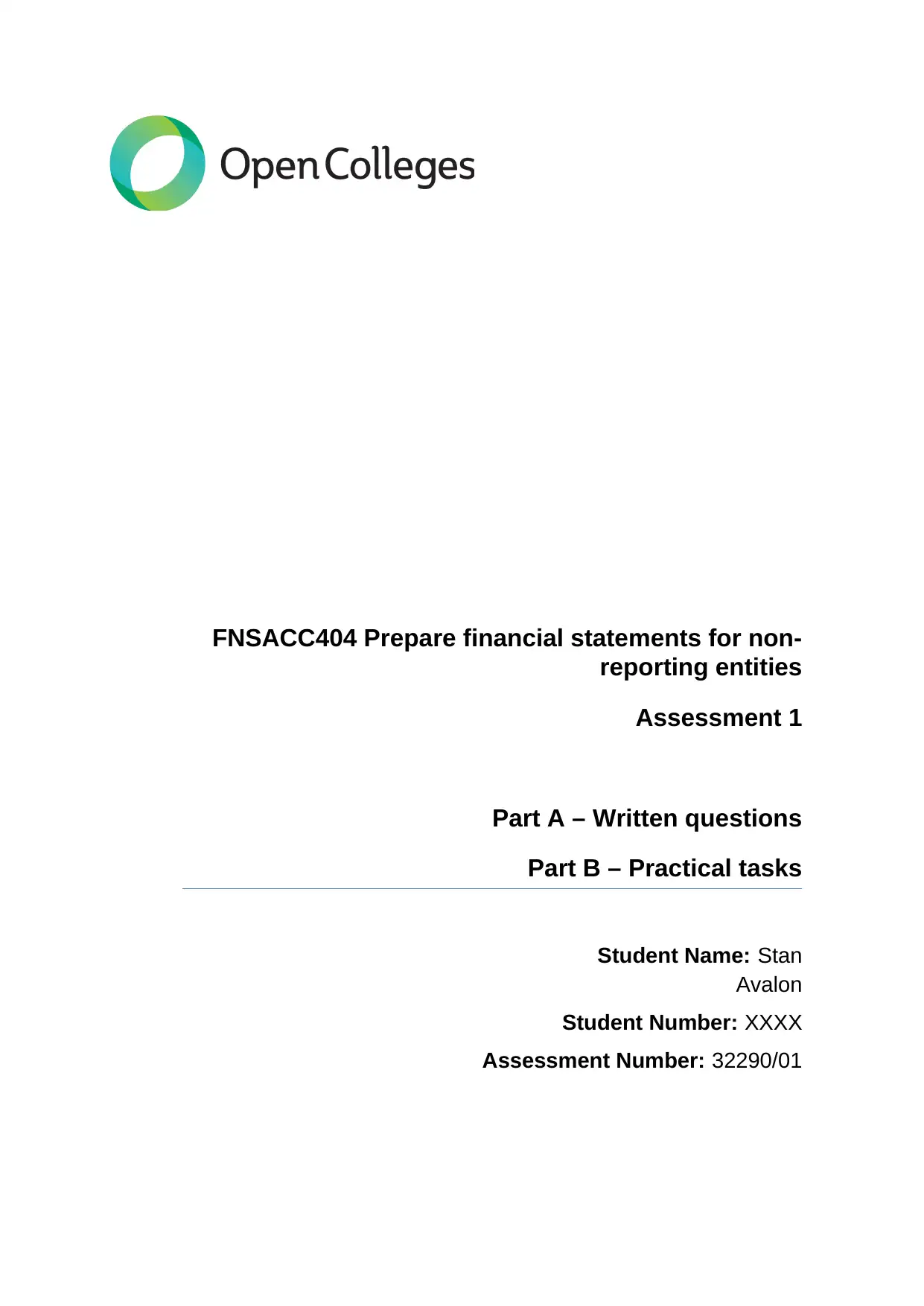
FNSACC404 Prepare financial statements for non-
reporting entities
Assessment 1
Part A – Written questions
Part B – Practical tasks
Student Name: Stan
Avalon
Student Number: XXXX
Assessment Number: 32290/01
reporting entities
Assessment 1
Part A – Written questions
Part B – Practical tasks
Student Name: Stan
Avalon
Student Number: XXXX
Assessment Number: 32290/01
Paraphrase This Document
Need a fresh take? Get an instant paraphrase of this document with our AI Paraphraser

All terms mentioned in this text that are known to be trademarks or service marks have been
appropriately capitalised. Use of a term in this text should not be regarded as affecting the
validity of any trademark or service mark.
© Open Colleges Pty Ltd, 2015
All rights reserved. No part of the material protected by this copyright may be reproduced or
utilised in any form or by any means, electronic or mechanical, including photocopying,
recording, or by any information storage and retrieval system, without permission in writing from
the copyright owner.
Page 2 of 65
appropriately capitalised. Use of a term in this text should not be regarded as affecting the
validity of any trademark or service mark.
© Open Colleges Pty Ltd, 2015
All rights reserved. No part of the material protected by this copyright may be reproduced or
utilised in any form or by any means, electronic or mechanical, including photocopying,
recording, or by any information storage and retrieval system, without permission in writing from
the copyright owner.
Page 2 of 65
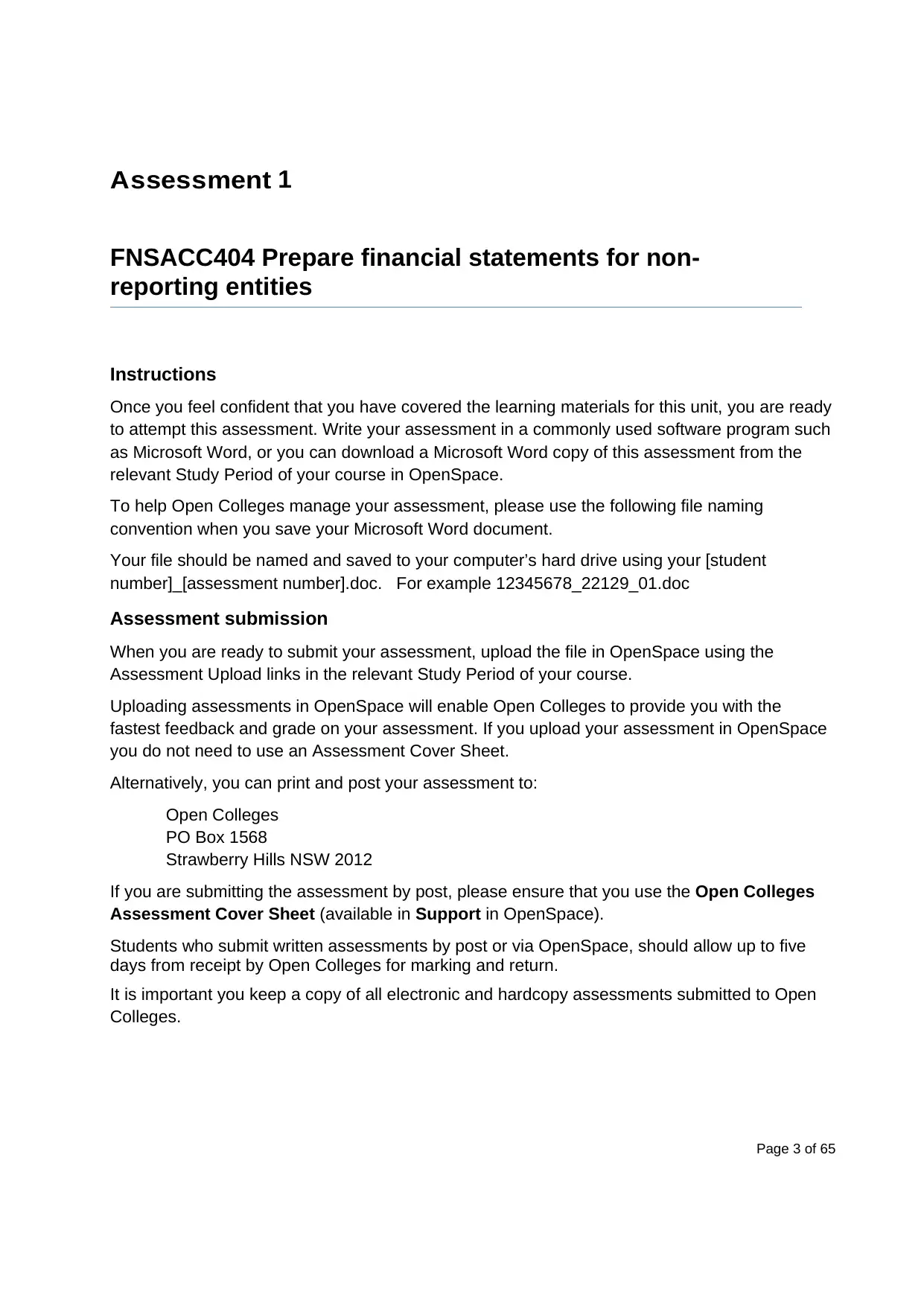
Assessment 1
FNSACC404 Prepare financial statements for non-
reporting entities
Instructions
Once you feel confident that you have covered the learning materials for this unit, you are ready
to attempt this assessment. Write your assessment in a commonly used software program such
as Microsoft Word, or you can download a Microsoft Word copy of this assessment from the
relevant Study Period of your course in OpenSpace.
To help Open Colleges manage your assessment, please use the following file naming
convention when you save your Microsoft Word document.
Your file should be named and saved to your computer’s hard drive using your [student
number]_[assessment number].doc. For example 12345678_22129_01.doc
Assessment submission
When you are ready to submit your assessment, upload the file in OpenSpace using the
Assessment Upload links in the relevant Study Period of your course.
Uploading assessments in OpenSpace will enable Open Colleges to provide you with the
fastest feedback and grade on your assessment. If you upload your assessment in OpenSpace
you do not need to use an Assessment Cover Sheet.
Alternatively, you can print and post your assessment to:
Open Colleges
PO Box 1568
Strawberry Hills NSW 2012
If you are submitting the assessment by post, please ensure that you use the Open Colleges
Assessment Cover Sheet (available in Support in OpenSpace).
Students who submit written assessments by post or via OpenSpace, should allow up to five
days from receipt by Open Colleges for marking and return.
It is important you keep a copy of all electronic and hardcopy assessments submitted to Open
Colleges.
Page 3 of 65
FNSACC404 Prepare financial statements for non-
reporting entities
Instructions
Once you feel confident that you have covered the learning materials for this unit, you are ready
to attempt this assessment. Write your assessment in a commonly used software program such
as Microsoft Word, or you can download a Microsoft Word copy of this assessment from the
relevant Study Period of your course in OpenSpace.
To help Open Colleges manage your assessment, please use the following file naming
convention when you save your Microsoft Word document.
Your file should be named and saved to your computer’s hard drive using your [student
number]_[assessment number].doc. For example 12345678_22129_01.doc
Assessment submission
When you are ready to submit your assessment, upload the file in OpenSpace using the
Assessment Upload links in the relevant Study Period of your course.
Uploading assessments in OpenSpace will enable Open Colleges to provide you with the
fastest feedback and grade on your assessment. If you upload your assessment in OpenSpace
you do not need to use an Assessment Cover Sheet.
Alternatively, you can print and post your assessment to:
Open Colleges
PO Box 1568
Strawberry Hills NSW 2012
If you are submitting the assessment by post, please ensure that you use the Open Colleges
Assessment Cover Sheet (available in Support in OpenSpace).
Students who submit written assessments by post or via OpenSpace, should allow up to five
days from receipt by Open Colleges for marking and return.
It is important you keep a copy of all electronic and hardcopy assessments submitted to Open
Colleges.
Page 3 of 65
⊘ This is a preview!⊘
Do you want full access?
Subscribe today to unlock all pages.

Trusted by 1+ million students worldwide
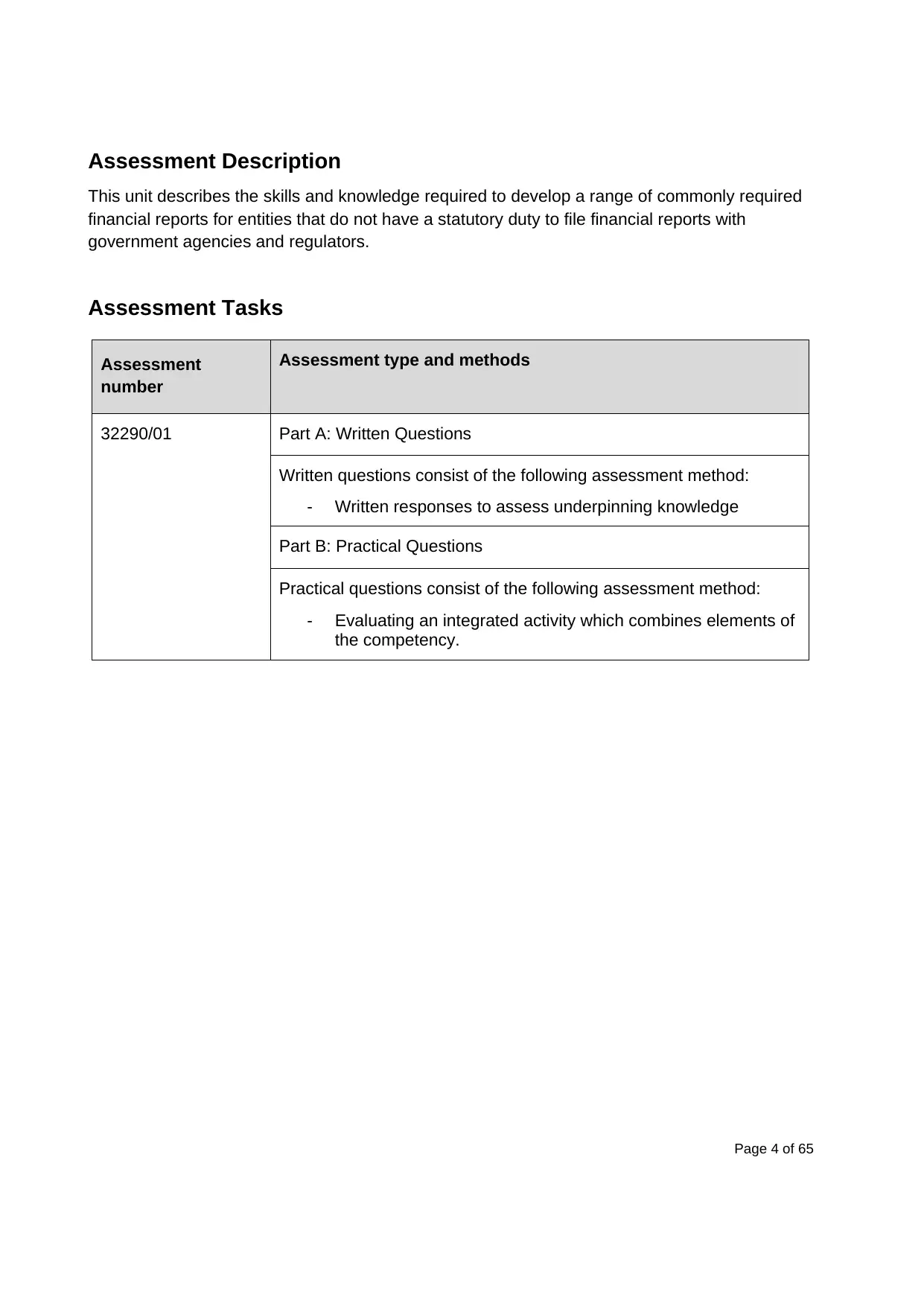
Assessment Description
This unit describes the skills and knowledge required to develop a range of commonly required
financial reports for entities that do not have a statutory duty to file financial reports with
government agencies and regulators.
Assessment Tasks
Assessment
number
Assessment type and methods
32290/01 Part A: Written Questions
Written questions consist of the following assessment method:
- Written responses to assess underpinning knowledge
Part B: Practical Questions
Practical questions consist of the following assessment method:
- Evaluating an integrated activity which combines elements of
the competency.
Page 4 of 65
This unit describes the skills and knowledge required to develop a range of commonly required
financial reports for entities that do not have a statutory duty to file financial reports with
government agencies and regulators.
Assessment Tasks
Assessment
number
Assessment type and methods
32290/01 Part A: Written Questions
Written questions consist of the following assessment method:
- Written responses to assess underpinning knowledge
Part B: Practical Questions
Practical questions consist of the following assessment method:
- Evaluating an integrated activity which combines elements of
the competency.
Page 4 of 65
Paraphrase This Document
Need a fresh take? Get an instant paraphrase of this document with our AI Paraphraser
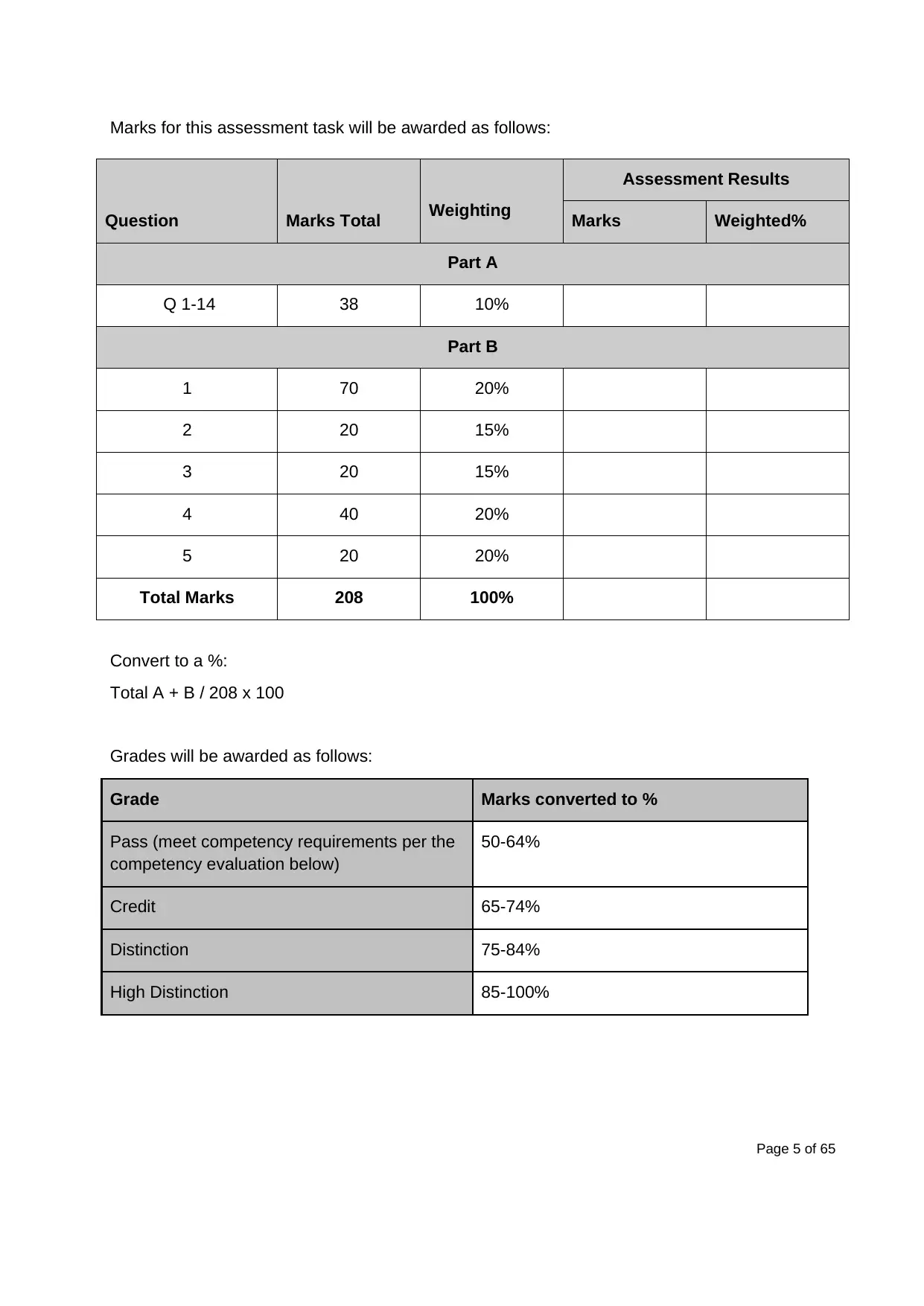
Marks for this assessment task will be awarded as follows:
Question Marks Total Weighting
Assessment Results
Marks Weighted%
Part A
Q 1-14 38 10%
Part B
1 70 20%
2 20 15%
3 20 15%
4 40 20%
5 20 20%
Total Marks 208 100%
Convert to a %:
Total A + B / 208 x 100
Grades will be awarded as follows:
Grade Marks converted to %
Pass (meet competency requirements per the
competency evaluation below)
50-64%
Credit 65-74%
Distinction 75-84%
High Distinction 85-100%
Page 5 of 65
Question Marks Total Weighting
Assessment Results
Marks Weighted%
Part A
Q 1-14 38 10%
Part B
1 70 20%
2 20 15%
3 20 15%
4 40 20%
5 20 20%
Total Marks 208 100%
Convert to a %:
Total A + B / 208 x 100
Grades will be awarded as follows:
Grade Marks converted to %
Pass (meet competency requirements per the
competency evaluation below)
50-64%
Credit 65-74%
Distinction 75-84%
High Distinction 85-100%
Page 5 of 65
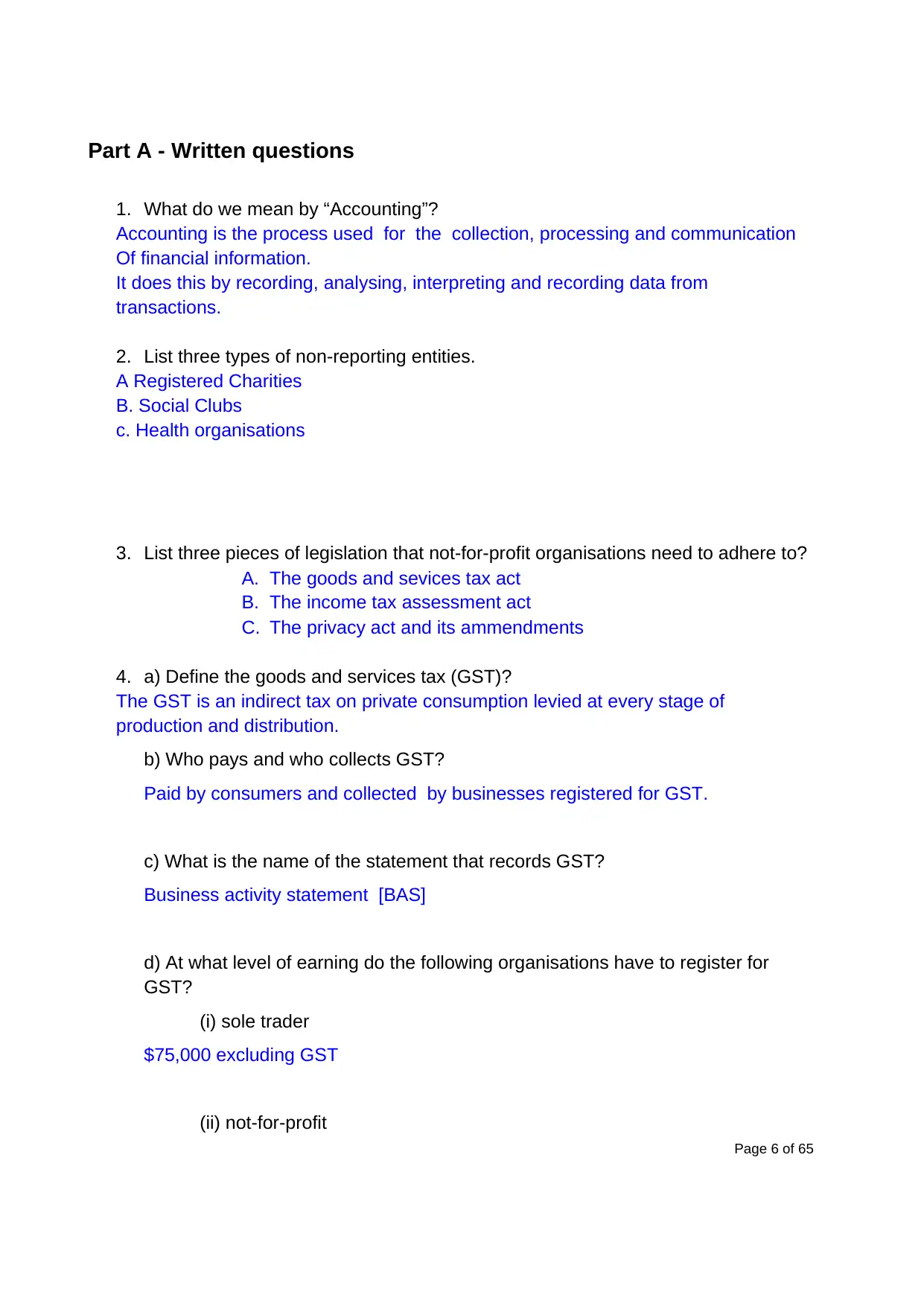
Part A - Written questions
1. What do we mean by “Accounting”?
Accounting is the process used for the collection, processing and communication
Of financial information.
It does this by recording, analysing, interpreting and recording data from
transactions.
2. List three types of non-reporting entities.
A Registered Charities
B. Social Clubs
c. Health organisations
3. List three pieces of legislation that not-for-profit organisations need to adhere to?
A. The goods and sevices tax act
B. The income tax assessment act
C. The privacy act and its ammendments
4. a) Define the goods and services tax (GST)?
The GST is an indirect tax on private consumption levied at every stage of
production and distribution.
b) Who pays and who collects GST?
Paid by consumers and collected by businesses registered for GST.
c) What is the name of the statement that records GST?
Business activity statement [BAS]
d) At what level of earning do the following organisations have to register for
GST?
(i) sole trader
$75,000 excluding GST
(ii) not-for-profit
Page 6 of 65
1. What do we mean by “Accounting”?
Accounting is the process used for the collection, processing and communication
Of financial information.
It does this by recording, analysing, interpreting and recording data from
transactions.
2. List three types of non-reporting entities.
A Registered Charities
B. Social Clubs
c. Health organisations
3. List three pieces of legislation that not-for-profit organisations need to adhere to?
A. The goods and sevices tax act
B. The income tax assessment act
C. The privacy act and its ammendments
4. a) Define the goods and services tax (GST)?
The GST is an indirect tax on private consumption levied at every stage of
production and distribution.
b) Who pays and who collects GST?
Paid by consumers and collected by businesses registered for GST.
c) What is the name of the statement that records GST?
Business activity statement [BAS]
d) At what level of earning do the following organisations have to register for
GST?
(i) sole trader
$75,000 excluding GST
(ii) not-for-profit
Page 6 of 65
⊘ This is a preview!⊘
Do you want full access?
Subscribe today to unlock all pages.

Trusted by 1+ million students worldwide
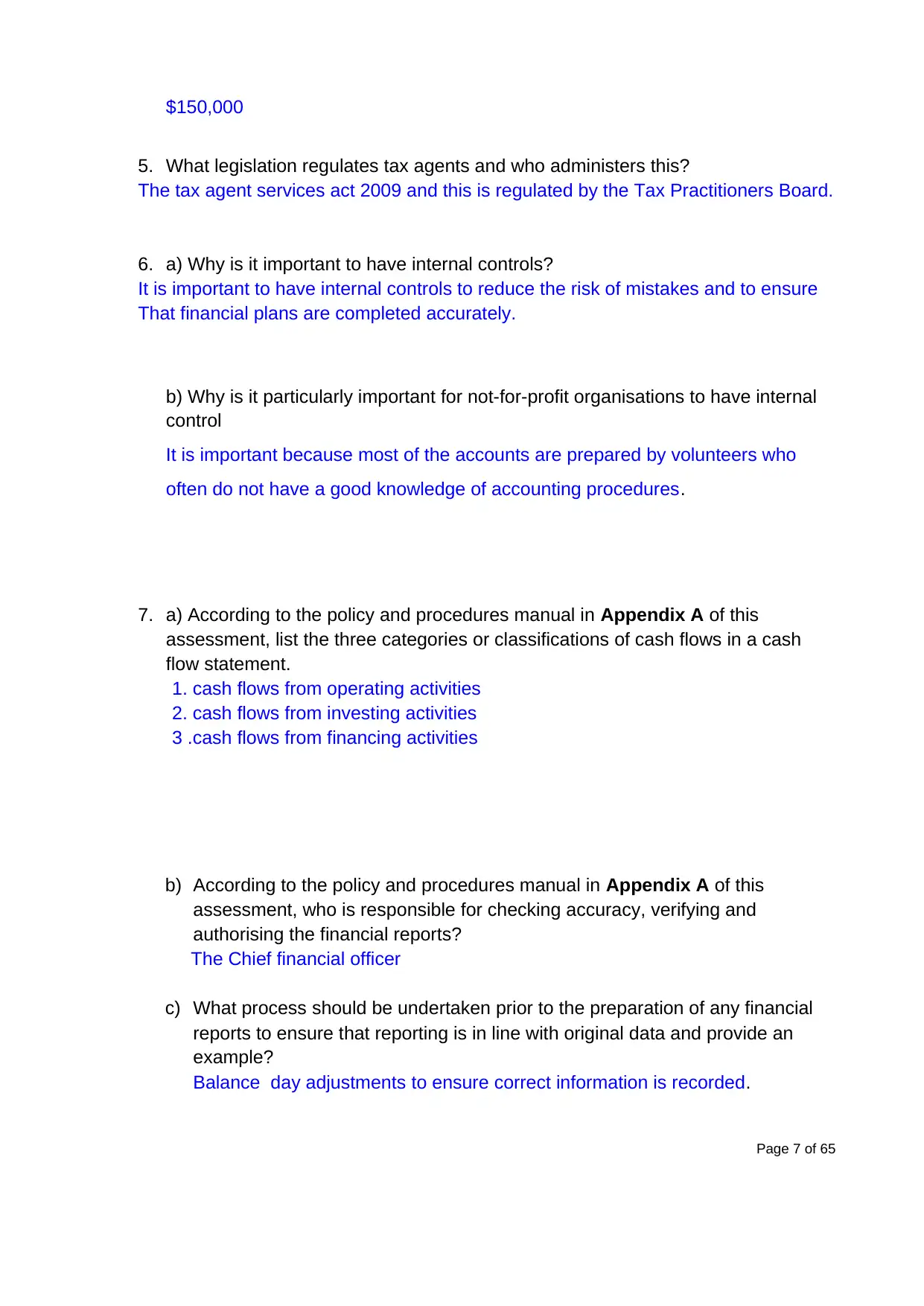
$150,000
5. What legislation regulates tax agents and who administers this?
The tax agent services act 2009 and this is regulated by the Tax Practitioners Board.
6. a) Why is it important to have internal controls?
It is important to have internal controls to reduce the risk of mistakes and to ensure
That financial plans are completed accurately.
b) Why is it particularly important for not-for-profit organisations to have internal
control
It is important because most of the accounts are prepared by volunteers who
often do not have a good knowledge of accounting procedures.
7. a) According to the policy and procedures manual in Appendix A of this
assessment, list the three categories or classifications of cash flows in a cash
flow statement.
1. cash flows from operating activities
2. cash flows from investing activities
3 .cash flows from financing activities
b) According to the policy and procedures manual in Appendix A of this
assessment, who is responsible for checking accuracy, verifying and
authorising the financial reports?
The Chief financial officer
c) What process should be undertaken prior to the preparation of any financial
reports to ensure that reporting is in line with original data and provide an
example?
Balance day adjustments to ensure correct information is recorded.
Page 7 of 65
5. What legislation regulates tax agents and who administers this?
The tax agent services act 2009 and this is regulated by the Tax Practitioners Board.
6. a) Why is it important to have internal controls?
It is important to have internal controls to reduce the risk of mistakes and to ensure
That financial plans are completed accurately.
b) Why is it particularly important for not-for-profit organisations to have internal
control
It is important because most of the accounts are prepared by volunteers who
often do not have a good knowledge of accounting procedures.
7. a) According to the policy and procedures manual in Appendix A of this
assessment, list the three categories or classifications of cash flows in a cash
flow statement.
1. cash flows from operating activities
2. cash flows from investing activities
3 .cash flows from financing activities
b) According to the policy and procedures manual in Appendix A of this
assessment, who is responsible for checking accuracy, verifying and
authorising the financial reports?
The Chief financial officer
c) What process should be undertaken prior to the preparation of any financial
reports to ensure that reporting is in line with original data and provide an
example?
Balance day adjustments to ensure correct information is recorded.
Page 7 of 65
Paraphrase This Document
Need a fresh take? Get an instant paraphrase of this document with our AI Paraphraser
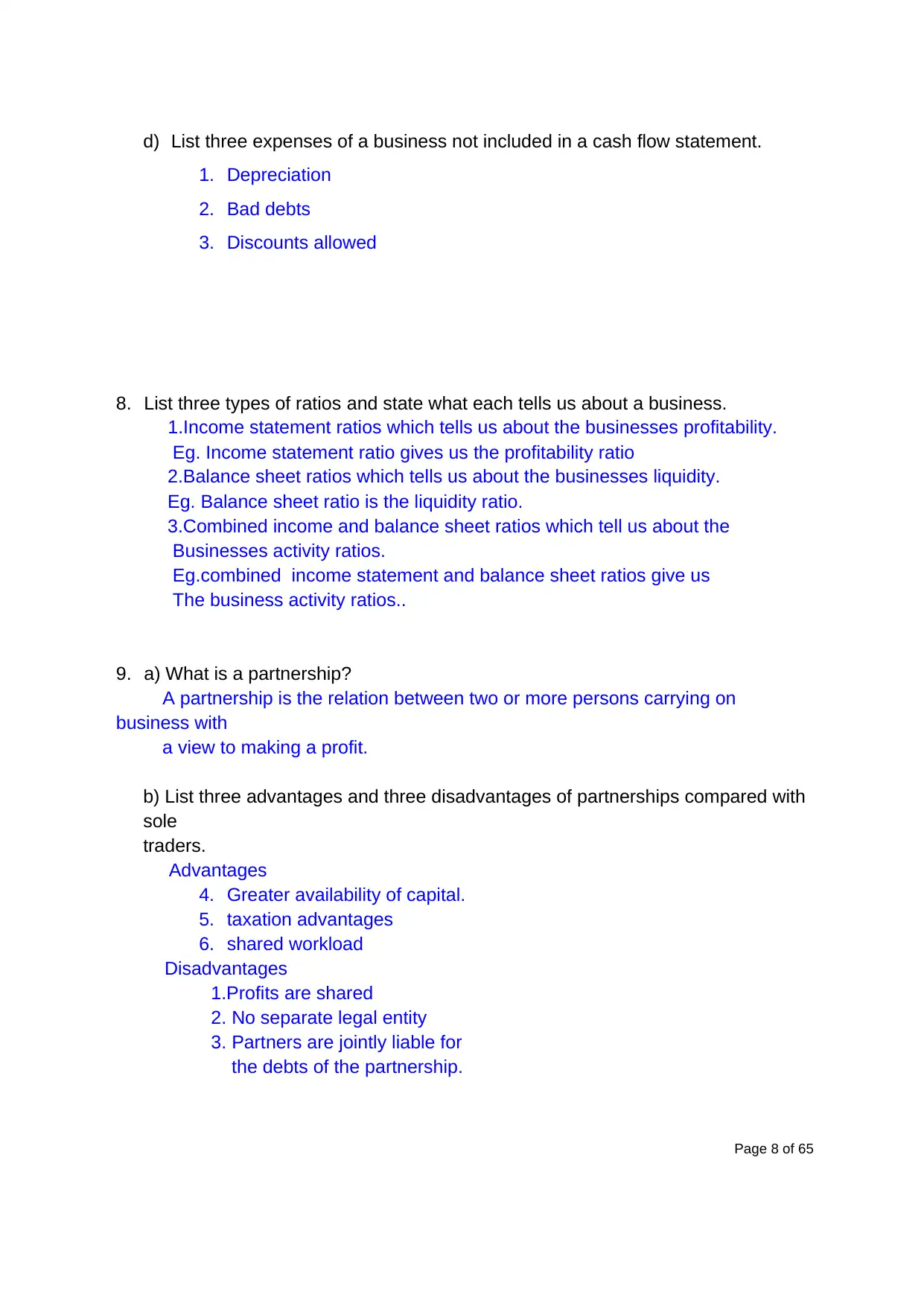
d) List three expenses of a business not included in a cash flow statement.
1. Depreciation
2. Bad debts
3. Discounts allowed
8. List three types of ratios and state what each tells us about a business.
1.Income statement ratios which tells us about the businesses profitability.
Eg. Income statement ratio gives us the profitability ratio
2.Balance sheet ratios which tells us about the businesses liquidity.
Eg. Balance sheet ratio is the liquidity ratio.
3.Combined income and balance sheet ratios which tell us about the
Businesses activity ratios.
Eg.combined income statement and balance sheet ratios give us
The business activity ratios..
9. a) What is a partnership?
A partnership is the relation between two or more persons carrying on
business with
a view to making a profit.
b) List three advantages and three disadvantages of partnerships compared with
sole
traders.
Advantages
4. Greater availability of capital.
5. taxation advantages
6. shared workload
Disadvantages
1.Profits are shared
2. No separate legal entity
3. Partners are jointly liable for
the debts of the partnership.
Page 8 of 65
1. Depreciation
2. Bad debts
3. Discounts allowed
8. List three types of ratios and state what each tells us about a business.
1.Income statement ratios which tells us about the businesses profitability.
Eg. Income statement ratio gives us the profitability ratio
2.Balance sheet ratios which tells us about the businesses liquidity.
Eg. Balance sheet ratio is the liquidity ratio.
3.Combined income and balance sheet ratios which tell us about the
Businesses activity ratios.
Eg.combined income statement and balance sheet ratios give us
The business activity ratios..
9. a) What is a partnership?
A partnership is the relation between two or more persons carrying on
business with
a view to making a profit.
b) List three advantages and three disadvantages of partnerships compared with
sole
traders.
Advantages
4. Greater availability of capital.
5. taxation advantages
6. shared workload
Disadvantages
1.Profits are shared
2. No separate legal entity
3. Partners are jointly liable for
the debts of the partnership.
Page 8 of 65
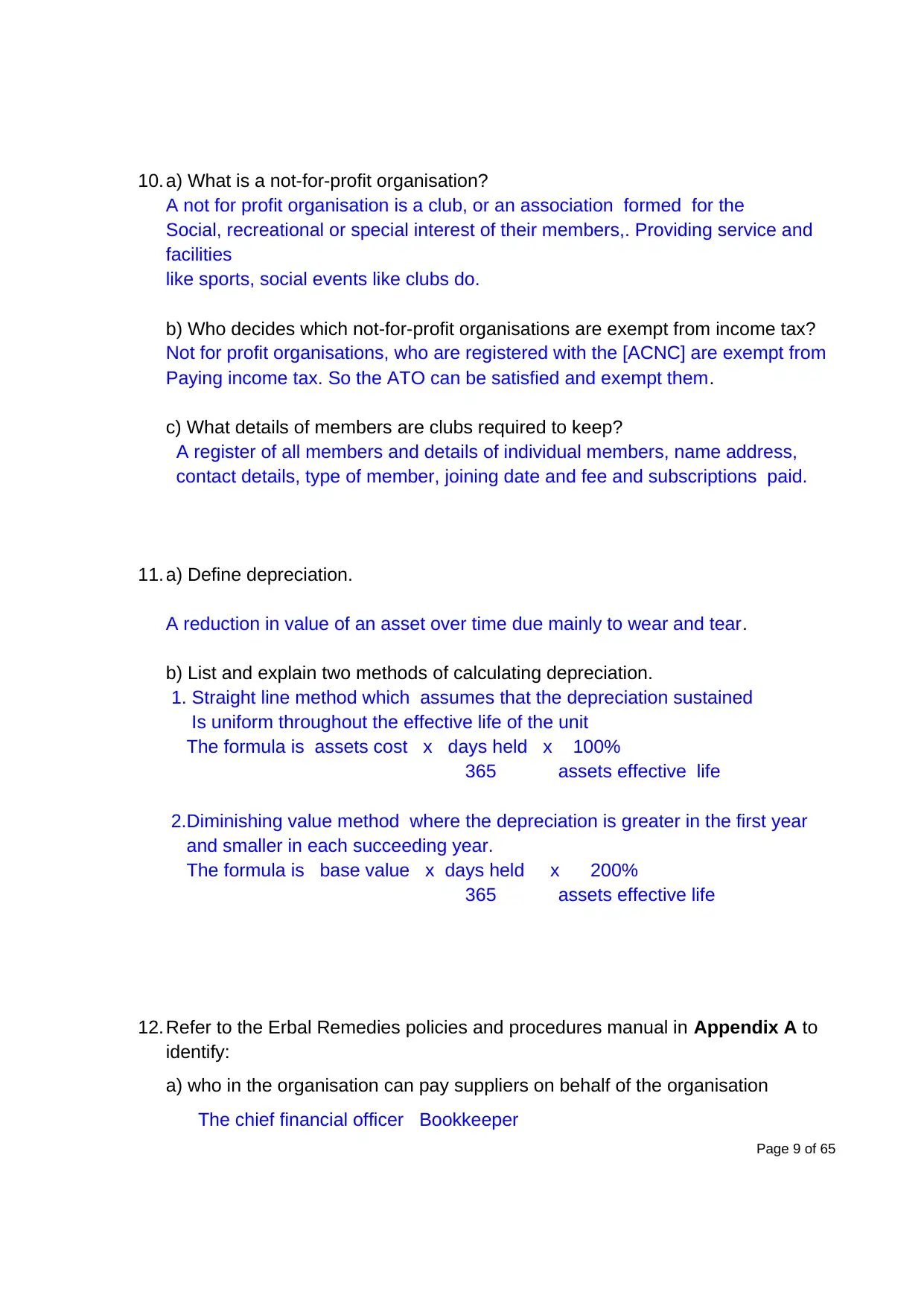
10. a) What is a not-for-profit organisation?
A not for profit organisation is a club, or an association formed for the
Social, recreational or special interest of their members,. Providing service and
facilities
like sports, social events like clubs do.
b) Who decides which not-for-profit organisations are exempt from income tax?
Not for profit organisations, who are registered with the [ACNC] are exempt from
Paying income tax. So the ATO can be satisfied and exempt them.
c) What details of members are clubs required to keep?
A register of all members and details of individual members, name address,
contact details, type of member, joining date and fee and subscriptions paid.
11. a) Define depreciation.
A reduction in value of an asset over time due mainly to wear and tear.
b) List and explain two methods of calculating depreciation.
1. Straight line method which assumes that the depreciation sustained
Is uniform throughout the effective life of the unit
The formula is assets cost x days held x 100%
365 assets effective life
2.Diminishing value method where the depreciation is greater in the first year
and smaller in each succeeding year.
The formula is base value x days held x 200%
365 assets effective life
12. Refer to the Erbal Remedies policies and procedures manual in Appendix A to
identify:
a) who in the organisation can pay suppliers on behalf of the organisation
The chief financial officer Bookkeeper
Page 9 of 65
A not for profit organisation is a club, or an association formed for the
Social, recreational or special interest of their members,. Providing service and
facilities
like sports, social events like clubs do.
b) Who decides which not-for-profit organisations are exempt from income tax?
Not for profit organisations, who are registered with the [ACNC] are exempt from
Paying income tax. So the ATO can be satisfied and exempt them.
c) What details of members are clubs required to keep?
A register of all members and details of individual members, name address,
contact details, type of member, joining date and fee and subscriptions paid.
11. a) Define depreciation.
A reduction in value of an asset over time due mainly to wear and tear.
b) List and explain two methods of calculating depreciation.
1. Straight line method which assumes that the depreciation sustained
Is uniform throughout the effective life of the unit
The formula is assets cost x days held x 100%
365 assets effective life
2.Diminishing value method where the depreciation is greater in the first year
and smaller in each succeeding year.
The formula is base value x days held x 200%
365 assets effective life
12. Refer to the Erbal Remedies policies and procedures manual in Appendix A to
identify:
a) who in the organisation can pay suppliers on behalf of the organisation
The chief financial officer Bookkeeper
Page 9 of 65
⊘ This is a preview!⊘
Do you want full access?
Subscribe today to unlock all pages.

Trusted by 1+ million students worldwide
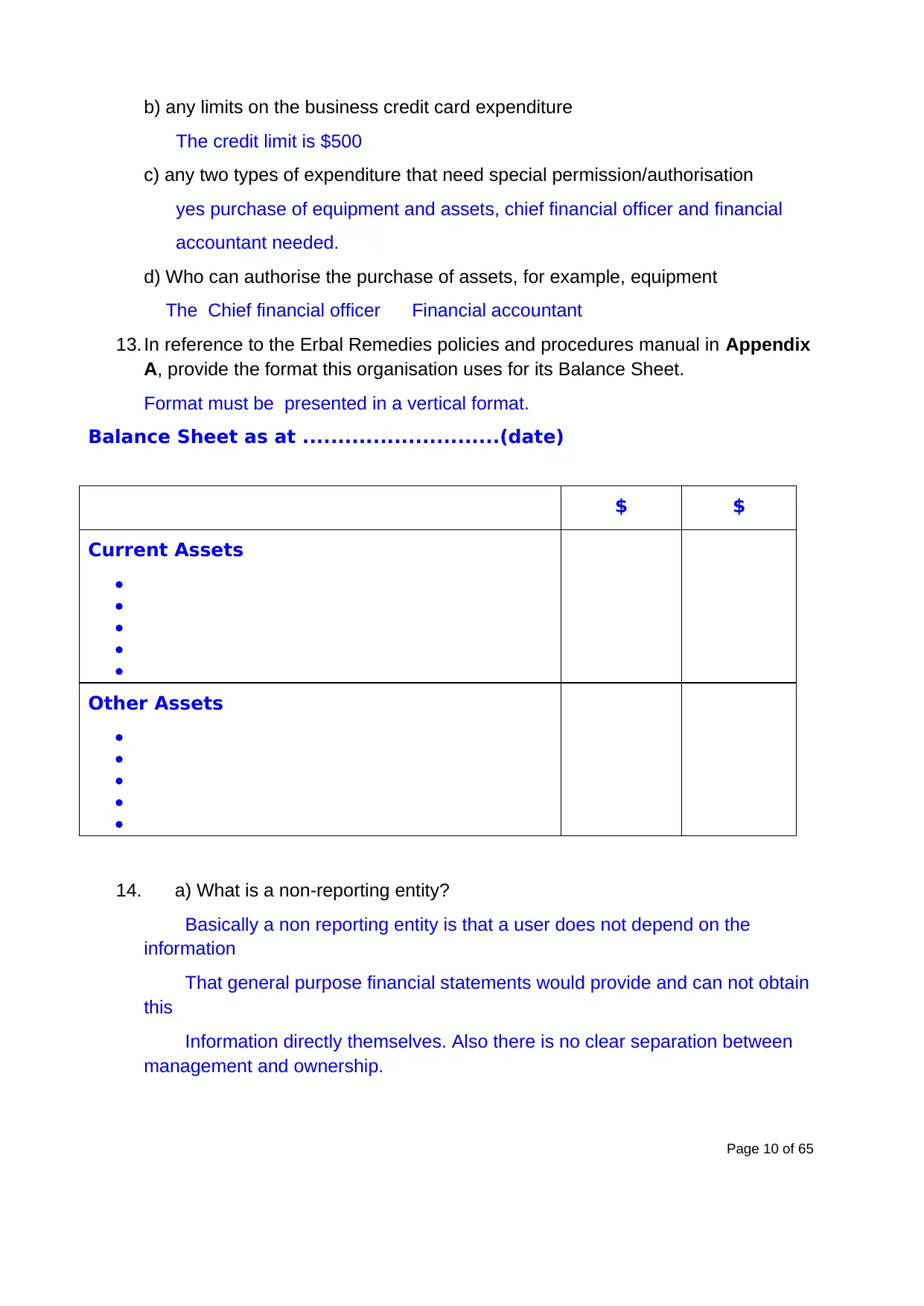
b) any limits on the business credit card expenditure
The credit limit is $500
c) any two types of expenditure that need special permission/authorisation
yes purchase of equipment and assets, chief financial officer and financial
accountant needed.
d) Who can authorise the purchase of assets, for example, equipment
The Chief financial officer Financial accountant
13. In reference to the Erbal Remedies policies and procedures manual in Appendix
A, provide the format this organisation uses for its Balance Sheet.
Format must be presented in a vertical format.
Balance Sheet as at ............................(date)
$ $
Current Assets
Other Assets
14. a) What is a non-reporting entity?
Basically a non reporting entity is that a user does not depend on the
information
That general purpose financial statements would provide and can not obtain
this
Information directly themselves. Also there is no clear separation between
management and ownership.
Page 10 of 65
The credit limit is $500
c) any two types of expenditure that need special permission/authorisation
yes purchase of equipment and assets, chief financial officer and financial
accountant needed.
d) Who can authorise the purchase of assets, for example, equipment
The Chief financial officer Financial accountant
13. In reference to the Erbal Remedies policies and procedures manual in Appendix
A, provide the format this organisation uses for its Balance Sheet.
Format must be presented in a vertical format.
Balance Sheet as at ............................(date)
$ $
Current Assets
Other Assets
14. a) What is a non-reporting entity?
Basically a non reporting entity is that a user does not depend on the
information
That general purpose financial statements would provide and can not obtain
this
Information directly themselves. Also there is no clear separation between
management and ownership.
Page 10 of 65
Paraphrase This Document
Need a fresh take? Get an instant paraphrase of this document with our AI Paraphraser
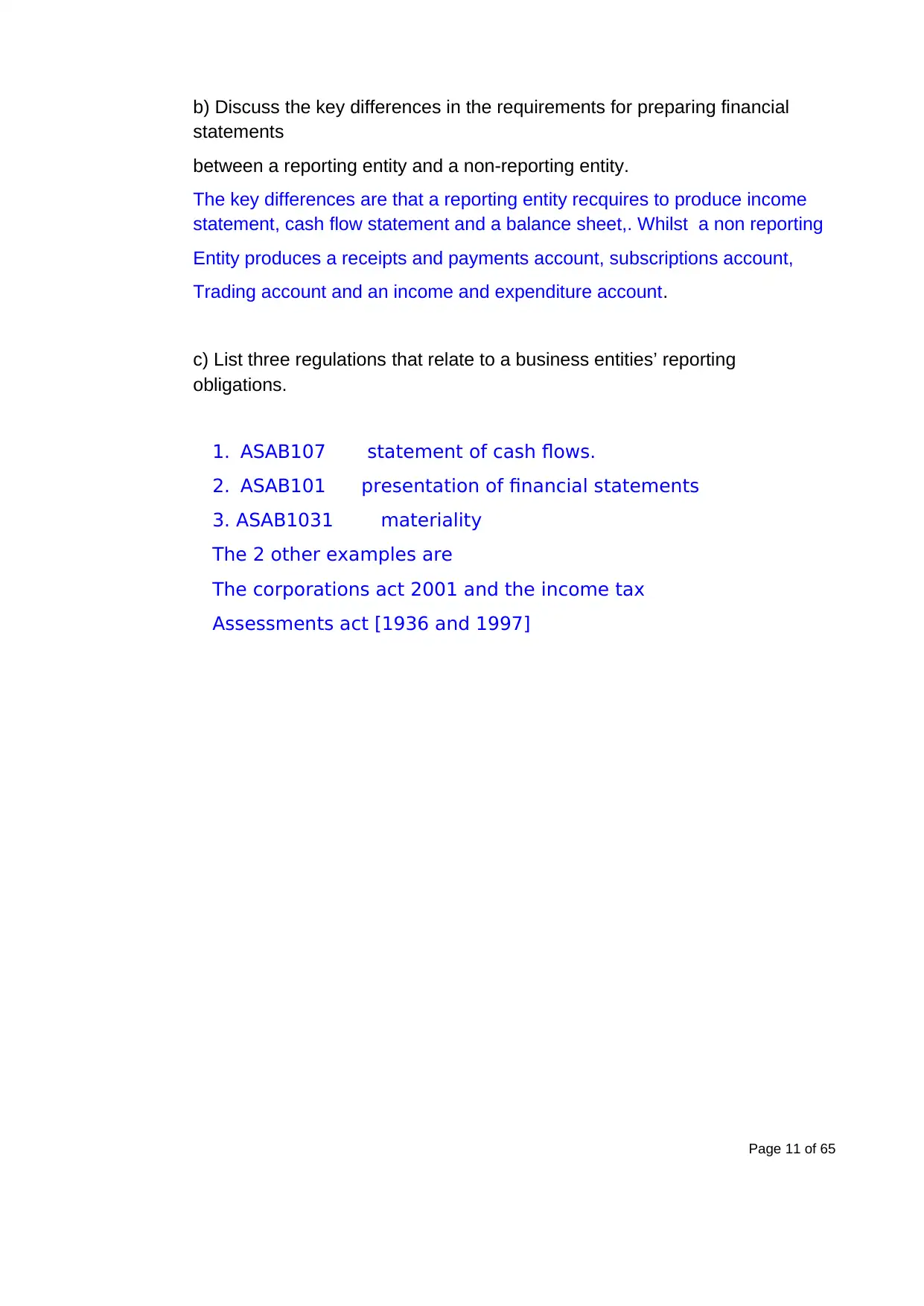
b) Discuss the key differences in the requirements for preparing financial
statements
between a reporting entity and a non-reporting entity.
The key differences are that a reporting entity recquires to produce income
statement, cash flow statement and a balance sheet,. Whilst a non reporting
Entity produces a receipts and payments account, subscriptions account,
Trading account and an income and expenditure account.
c) List three regulations that relate to a business entities’ reporting
obligations.
1. ASAB107 statement of cash flows.
2. ASAB101 presentation of financial statements
3. ASAB1031 materiality
The 2 other examples are
The corporations act 2001 and the income tax
Assessments act [1936 and 1997]
Page 11 of 65
statements
between a reporting entity and a non-reporting entity.
The key differences are that a reporting entity recquires to produce income
statement, cash flow statement and a balance sheet,. Whilst a non reporting
Entity produces a receipts and payments account, subscriptions account,
Trading account and an income and expenditure account.
c) List three regulations that relate to a business entities’ reporting
obligations.
1. ASAB107 statement of cash flows.
2. ASAB101 presentation of financial statements
3. ASAB1031 materiality
The 2 other examples are
The corporations act 2001 and the income tax
Assessments act [1936 and 1997]
Page 11 of 65
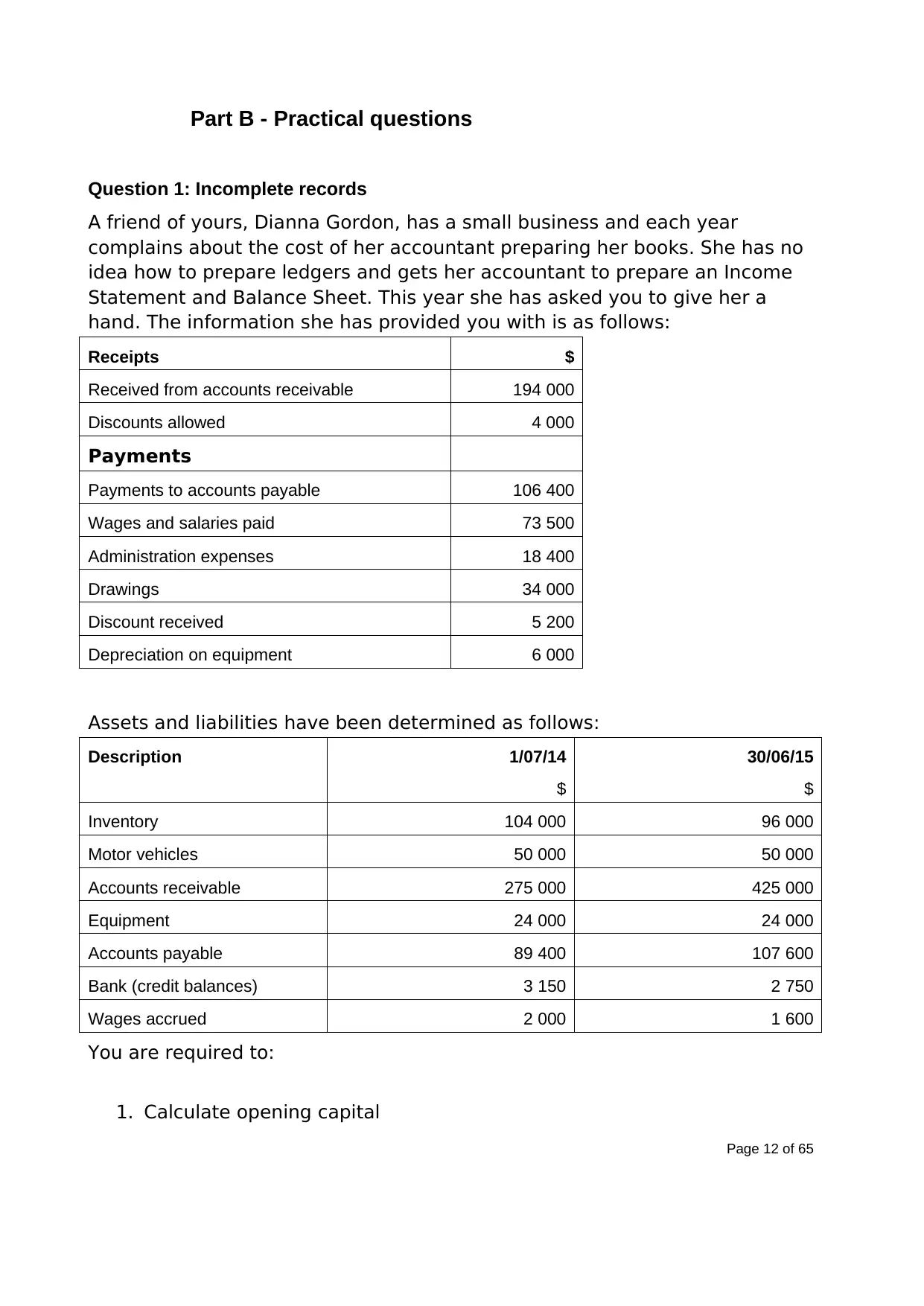
Part B - Practical questions
Question 1: Incomplete records
A friend of yours, Dianna Gordon, has a small business and each year
complains about the cost of her accountant preparing her books. She has no
idea how to prepare ledgers and gets her accountant to prepare an Income
Statement and Balance Sheet. This year she has asked you to give her a
hand. The information she has provided you with is as follows:
Receipts $
Received from accounts receivable 194 000
Discounts allowed 4 000
Payments
Payments to accounts payable 106 400
Wages and salaries paid 73 500
Administration expenses 18 400
Drawings 34 000
Discount received 5 200
Depreciation on equipment 6 000
Assets and liabilities have been determined as follows:
Description 1/07/14
$
30/06/15
$
Inventory 104 000 96 000
Motor vehicles 50 000 50 000
Accounts receivable 275 000 425 000
Equipment 24 000 24 000
Accounts payable 89 400 107 600
Bank (credit balances) 3 150 2 750
Wages accrued 2 000 1 600
You are required to:
1. Calculate opening capital
Page 12 of 65
Question 1: Incomplete records
A friend of yours, Dianna Gordon, has a small business and each year
complains about the cost of her accountant preparing her books. She has no
idea how to prepare ledgers and gets her accountant to prepare an Income
Statement and Balance Sheet. This year she has asked you to give her a
hand. The information she has provided you with is as follows:
Receipts $
Received from accounts receivable 194 000
Discounts allowed 4 000
Payments
Payments to accounts payable 106 400
Wages and salaries paid 73 500
Administration expenses 18 400
Drawings 34 000
Discount received 5 200
Depreciation on equipment 6 000
Assets and liabilities have been determined as follows:
Description 1/07/14
$
30/06/15
$
Inventory 104 000 96 000
Motor vehicles 50 000 50 000
Accounts receivable 275 000 425 000
Equipment 24 000 24 000
Accounts payable 89 400 107 600
Bank (credit balances) 3 150 2 750
Wages accrued 2 000 1 600
You are required to:
1. Calculate opening capital
Page 12 of 65
⊘ This is a preview!⊘
Do you want full access?
Subscribe today to unlock all pages.

Trusted by 1+ million students worldwide
1 out of 65
Related Documents
Your All-in-One AI-Powered Toolkit for Academic Success.
+13062052269
info@desklib.com
Available 24*7 on WhatsApp / Email
![[object Object]](/_next/static/media/star-bottom.7253800d.svg)
Unlock your academic potential
Copyright © 2020–2025 A2Z Services. All Rights Reserved. Developed and managed by ZUCOL.





